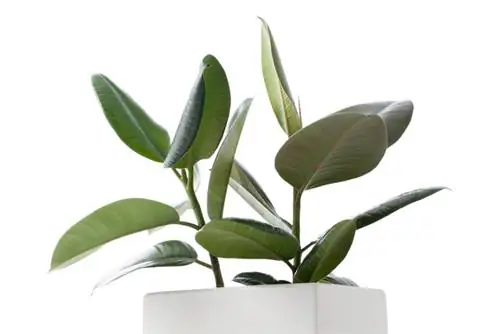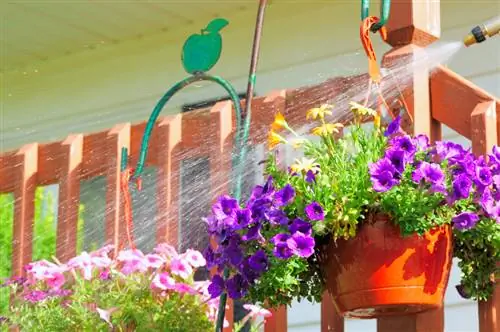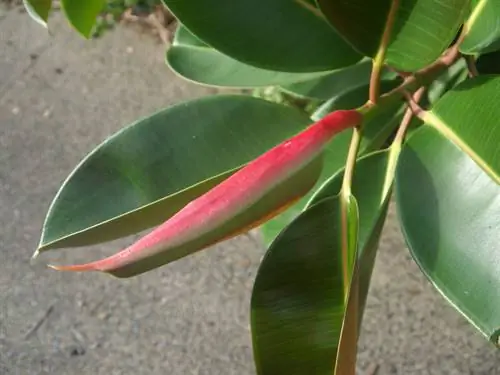- Author admin [email protected].
- Public 2023-12-16 16:46.
- Last modified 2025-01-23 11:20.
Very popular in the 1960s, the rubber tree has lost much of its appeal as a houseplant. It is not old-fashioned at all but very easy to care for and can be found in different shades of color. It can be easily propagated via cuttings.

How do I properly care for a rubber tree?
Rubber tree care includes a bright to partially shaded location, moderate watering with water at room temperature, fertilizing every two to three weeks and a cool winter break from October to February. Propagation is best done by cuttings.
Planting the rubber tree correctly
With its low nutrient requirements, the rubber tree does not require any special substrate; commercial potting soil or slightly sandy soil is completely sufficient. The pH of the soil should be close to neutral. Choose a sufficiently large plant pot, as the rubber tree can grow up to three meters high. However, if necessary, it can also be repotted quite easily.
The best place for the rubber tree
The rubber tree likes it warm and bright. In contrast to many other houseplants, it also copes quite well with dry heating air. However, drafts cause him problems. That's why the rubber tree shouldn't necessarily be placed near a frequently opened window or at the door to the cold hallway.
If it feels comfortable, then the rubber tree can grow to the ceiling over time. In the wild, however, it reaches a height of 20 to 40 meters and the trunk can be up to 2 meters thick. The up to 40 cm large leaves can become light, then simply wipe them with a damp cloth.
Water and fertilize the rubber tree
The rubber tree should only be watered moderately. Wait until the top layer of soil has dried slightly. The rubber tree tolerates stale water at room temperature or rainwater best. Be sure to avoid waterlogging, as the rubber tree is quite sensitive to this. Under no circumstances should there be permanent water in the planter or saucer, as this can easily lead to rot.
As an alternative to regular watering, you can also “dip” your rubber tree from time to time. To do this, place the plant in a large container filled with water until the soil is saturated. If no more air bubbles rise from the water, then it is time to remove the rubber tree. Drain thoroughly.
Approximately every two to three weeks, fertilize your rubber tree with a commercially available liquid fertilizer (€6.00 on Amazon). Simply mix this into the irrigation water. The rubber tree does not need very many nutrients, so do not use the fertilizer too generously.
Diseases and pests of the rubber tree
With good care and in the right location, the rubber tree is quite robust against diseases or pests. If it is waterlogged or watered too much, it can easily lose its leaves.
The most common pests found on rubber trees are spider mites and mealybugs. However, they can be controlled biologically without the use of harsh chemicals. Check your rubber tree for pest infestation, especially during the heating season.
The rubber tree in winter
The rubber tree tolerates a slightly cool winter break very well; it can last from October to February. However, the temperature should not fall below around 16 °C during this time, as the rubber tree is quite sensitive to cold.
During the winter break, the rubber tree only needs a little water and should be fertilized a maximum of twice. If the potting soil is still relatively fresh, you can skip fertilizing in winter altogether.
Pruning the rubber tree
The rubber tree does not need regular cutting. However, it tolerates cutting well. If the rubber tree becomes too large, cut it to the desired height. You can use the cut piece for propagation straight away. You can also use side shoots for this purpose.
Propagate the rubber tree
The rubber tree can also be sown, but it is quite a difficult matter. Propagation through cuttings, on the other hand, is very easy. It is best to cut these from the side shoots in spring when the rubber tree forms new leaves. Rooting takes place in a glass of water or in moist potting soil. This takes around four to eight weeks. Only when the roots are strong should you repot the young rubber tree.
The most important things in brief:
- easy care
- good for beginners
- Bright to partially shaded location preferred
- Avoid drafts as much as possible
- Temperature preferably not below 16 °C
- More light is required for variegated varieties for beautiful coloring
- water or dip moderately
- cool winter break from October to February
- Propagation is best done by cuttings
- occasionally suffers from pests, especially in the heating season
Tip
The rubber tree is one of the easy-care houseplants suitable for beginners. In addition to light, warmth, water and fertilizer, it only needs a slightly cooler winter break to thrive.






